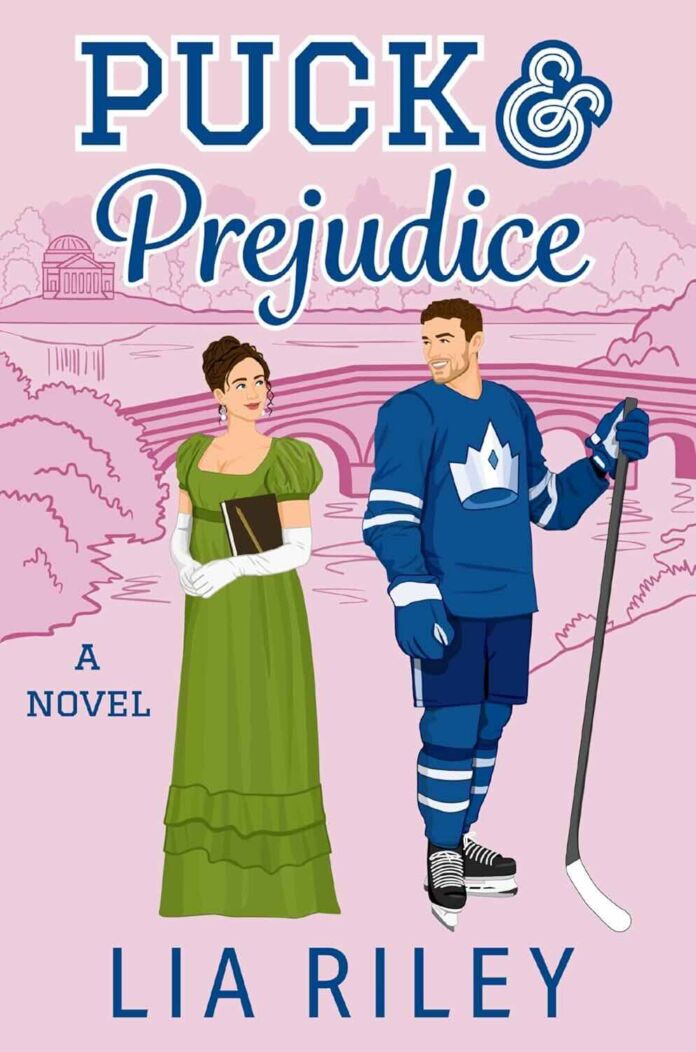In this unique blend of sports romance and time travel fiction, Lia Riley delivers an engaging tale that bridges two centuries through an unlikely love story. As a seasoned romance reader and sports enthusiast, I found Puck and Prejudice to be an ambitious crossover that largely succeeds in merging the worlds of professional hockey and Regency England, though occasionally stumbling in its execution.
Plot and Premise Analysis
The story follows Tucker Taylor, a professional hockey goalie for the Austin Regals, who finds himself unexpectedly transported to 1812 England after a near-fatal accident. There he meets Elizabeth “Lizzy” Wooddash, a spirited young woman who dreams of independence in an era that offers women few choices beyond marriage. Their initial agreement—to marry so Lizzy can eventually become a widow and gain freedom—evolves into something far more complex and emotionally resonant.
Strengths
- Creative Concept: The author skillfully weaves together elements of sports romance and historical fiction, creating a fresh take on both genres
- Character Development: Both protagonists show substantial growth throughout the narrative
- Historical Detail: Riley demonstrates careful research in depicting both Regency society and modern hockey culture
- Jane Austen Connection: The incorporation of Jane Austen as a character adds depth and authenticity to the historical setting
Areas for Improvement
- Pacing Issues: The middle section occasionally drags, particularly during the London society scenes
- Time Travel Mechanics: The explanation for the time travel phenomenon feels somewhat underdeveloped
- Secondary Character Development: Some supporting characters, particularly in the modern timeline, could use more depth
Character Analysis
Tucker Taylor
Riley crafts a compelling male lead in Tucker—a professional athlete with depth beyond his career. His struggle with cancer adds complexity to his character, though this subplot could have been explored more thoroughly. His adaptation to Regency society provides both humorous moments and touching insights into his character.
Elizabeth Wooddash
Lizzy emerges as a well-rounded protagonist whose desires and conflicts feel authentic to both her era and modern sensibilities. Her evolution from seeking independence through widowhood to discovering genuine love is particularly well-executed. Her friendship with Jane Austen adds an interesting layer to her characterization.
Writing Style and Narrative Structure
Riley’s prose strikes a balance between modern sports terminology and Regency-era dialogue, though occasionally the contrast feels jarring. The dual-timeline structure works effectively, and the author handles point-of-view shifts between Tucker and Lizzy with skill.
Notable Passages
The scenes at Ye Olde King’s Head bookend the story beautifully, and the hockey game sequences demonstrate Riley’s understanding of the sport. The romantic tension builds naturally, though some intimate scenes feel rushed compared to the overall pacing.
Historical Accuracy and Sports Detail
Riley shows commendable attention to historical detail, particularly in:
- Social conventions of the Regency era
- Period-appropriate dialogue
- Clothing and social customs
The hockey elements are equally well-researched, though some technical aspects of goaltending could have been more detailed for authenticity.
Romance Development
The central romance develops convincingly, despite the unusual circumstances. The author effectively builds tension through:
- Initial mutual distrust
- Gradual understanding
- Shared challenges
- Genuine emotional connection
Comparative Analysis
Puck and Prejudice stands out in both the sports romance and time travel romance subgenres. While it shares DNA with works like Diana Gabaldon’s Outlander series, it carves its own niche through its unique combination of elements.
Cultural Impact and Themes
The novel explores several compelling themes:
- Gender roles across time periods
- Personal autonomy versus societal expectations
- The nature of love versus convenience
- The impact of time on relationships
Technical Elements
World-Building
The author creates a believable version of both 1812 England and modern professional hockey, though the connection between them occasionally feels tenuous.
Dialogue
The contrast between modern and historical speech patterns is generally well-handled, though some anachronisms slip through.
Final Verdict
Strengths
- Innovative premise
- Strong character development
- Effective blend of genres
- Engaging romance
Weaknesses
- Some pacing issues
- Underdeveloped time travel mechanics
- Occasional historical inconsistencies
Recommendation
Puck and Prejudice will appeal to readers who enjoy:
- Creative genre blends
- Sports romance
- Historical fiction with modern elements
- Time travel romance
- Jane Austen-inspired works
Target Audience
This novel is best suited for:
- Romance readers seeking unique premises
- Sports romance enthusiasts
- Historical fiction fans open to modern elements
- Readers who enjoy genre-bending stories
Conclusion
Lia Riley’s Puck and Prejudice is an ambitious and largely successful blend of sports romance and historical fiction. While it has some technical flaws, the central romance and creative premise make it a worthwhile read for fans of either genre. The author’s previous works in the Regals Hockey series show similar creativity, though this represents her most ambitious effort yet.
For readers seeking similar works, consider Riley’s other hockey romances or time travel romances like Diana Gabaldon’s Outlander series or Susanna Kearsley’s historical time slip novels.





